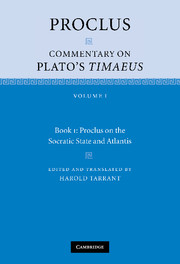Translation
Published online by Cambridge University Press: 15 January 2010
Summary
Prefatory remarks (1.1–14.3)
Preliminaries I: the target of the Timaeus
1It seems to me to be glaringly clear to all who are not utterly blind to serious literature that the aim of the Platonic Timaeus5 is firmly fixed upon the whole of physical inquiry, and involves the study of the All, dealing with this from beginning to end. Indeed, the Pythagorean Timaeus' own work has the title On Nature in the Pythagorean10 manner. This was, in the sillographer's words, [the point] ‘from which Plato began when he undertook to do Timaeus-writing’. We used this work as an introduction to our commentary, so that we should be able to know which of the claims of Plato's Timaeus15 are the same, which are additional, and which are actually in disagreement with the other man's – and make a point of searching for the reason for the disagreement. This whole dialogue, throughout its entire length, has physical inquiry as its aim, examining the same matters simultaneously in images and in paradigms, in wholes and in parts.20 It has been filled throughout with all the finest rules of physical theory, tackling simples for the sake of complexes, parts for the sake of wholes, and images for the sake of their originals, leaving none of the originative causes of nature outside the scope of the inquiry.
- Type
- Chapter
- Information
- Proclus: Commentary on Plato's Timaeus , pp. 91 - 304Publisher: Cambridge University PressPrint publication year: 2007

